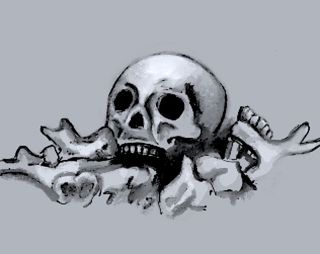Serial Killers
Suicide and the Cornered Killer
When investigators home in, certain types of killers opt out.
Posted June 11, 2024 Reviewed by Monica Vilhauer
Key points
- Some serial killers prepare to die when law enforcement catches up to them, depriving us of information.
- Herb Baumeister fled his home when cops prepared to search, killing himself before they could question him.
- Analyzing the type of killers who end their lives when cornered could help cops stop them.

Recent news has featured efforts to identify the victims of serial killer Herb Baumeister. From the thousands of bone fragments discovered in 1996 on his Indiana property, the DNA from four more victims has been submitted for genetic genealogical analysis. (Three others have been successfully identified.) Possibly a dozen more await analysis. Back then, such a feat had seemed impossible. Baumeister thought he’d effectively erased any chance of a victim being linked to him.
Then it all unraveled. His 15-year-old son found a skull in the yard. More bones turned up. Baumeister’s wife, who’d begun divorce proceedings, allowed law enforcement to search the property. Baumeister knew what they’d find, so he fled to Canada and shot himself. On his farm, cops found burn pits with thousands of charred and smashed bone fragments. It looked as if someone had sat there, drinking beer and watching the fire.
The story slowly emerged. Baumeister, a successful businessman and married father of three, had frequented gay bars when his wife was away to lure young men to Fox Hollow Farm. A man who’d experienced Baumeister’s MO reported on his seduction. At the bar, Baumeister had posed as a landscaper working on an estate who had keys to the “owner’s” fifteen-room Tudor mansion, and he wanted company. Once there with his “guest,” he tried to ply him with drinks, but the man declined. Baumeister removed his clothes for a swim and described a choking technique he used for “dangerous” sex. The man felt sure this “landscaper” intended him harm. He remained vigilant until he could leave. He was one of the few who got out alive.
Baumeister’s victim total remains unknown, and he’s even suspected in murders away from his property.
Psychologist David Lester described Baumeister in his 2010 analysis of suicidal serial killers vs. mass murderers. Not surprisingly, the risk for suicide is much higher for the latter group (for whom mass murder is often an extended suicidal gesture). Based on a sample of nearly 600 cases, Lester cites a statistic of 4.4% for serial killers. Of the serial killers, 17% killed themselves to avoid arrest and 23% completed suicide during the arrest process. Hanging and guns were the predominant methods. Lester suggests that Baumeister was ashamed of being gay, which had motivated him to kill the men he’d seduced, and did not want to be exposed for his proclivities.
Leonard Lake was another serial killer who’d formed a plan to avoid capture. Arrested for shoplifting, he swallowed a cyanide pill. Both men were lust killers who'd needed control.
Like mass murderers, spree killers might also be suicidal. Both types are generally driven by anger, a mission, or desperation, with the spree killer stringing out the assaults for a longer period and over a broader range of locales.
Former FBI profiler Mark Safarik and I collected over 350 cases involving 419 spree killers (some worked in teams) from more than 40 countries. To allow for data analytics, we grouped them into five categories: 1) Anger and Revenge, 2) Mission, 3) Desperation, 4) Mental Illness and 5) Robbery and Thrill. We also devised subcategories for each.
About 23.6% of the spree killers in our study committed suicide or attempted to. This figure skews lower than expected due to Category #5, which is large and generally non-suicidal. In addition, among those who were cornered in a shoot-out with police, it’s not possible to say whether they'd arranged a suicide-by-cop, unless they left a note or showed obviously suicidal behavior. Many of those who ended their lives during a spree fit the Desperation category (48% suicides or attempts). In the Mental Illness category, one in three killed themselves or attempted to, and about 37% did so in the Anger/Revenge category.
Extreme offenders like Baumeister are bold about exercising the power of life and death over others but seem to fear anyone having this same power over them. A careful analysis of the suicidal types among known killers could help law enforcement keep future killers alive. The chance to have interviewed Baumeister, for example, might have yielded information about victim identities earlier than the current, much more painstaking efforts.
References
Lester, D., Stack, S., Schmidtke, A., Schaller, S., & Müller, I. (2005). Mass homicide and suicide. Crisis, 26, 184-187.
Lester, D., & White, J. (2010). Suicide in serial killers. Psychological Reports, 106(1), 246-246. https://doi.org/10.2466/PR0.106.1.246
Safarik, M. & Ramsland, K. (2021). Spree killers: Practical classifications for law enforcement and criminology. CRC Press.
White, J., & Lester, D. (2008). Suicide and serial killers. American Journal of Forensic Psychiatry, 29(2), 41-45.


